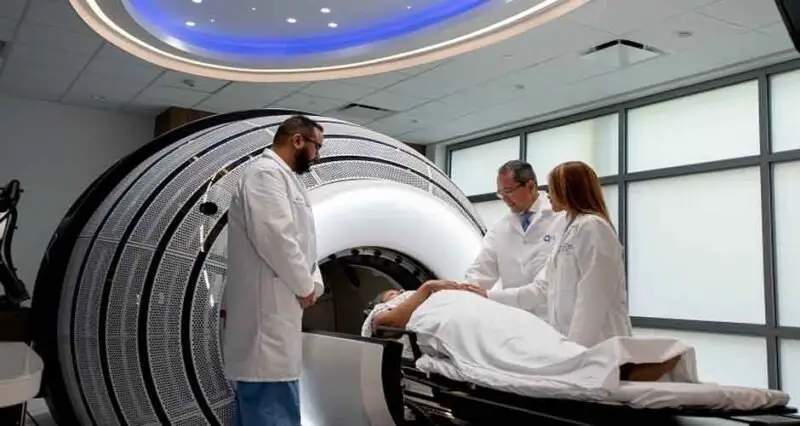
The intricate world of neurosurgery has been revolutionised by the advent of technology, introducing an era where precision, safety, and patient outcomes are reaching unprecedented heights. Key technological advancements, gripping the domain of neuroscience, are redefining the capabilities of surgeons and elevating patient care to new horizons.
From the intricacies of neuronavigation to the life-altering potential of advanced neuroimaging, the toolbox of the modern neurosurgeon has never been more equipped. This article embarks on a journey to explore the transformative technologies that are navigating us into a future of neurological marvels, setting new standards in the treatment and understanding of the human brain.
The Evolution of Neuroimaging
The historical journey of neuroimaging begins with rudimentary techniques only allowing glimpses into the complexity of the human brain. Over the years, sharper resolutions and deeper insights have been achieved, starkly contrasting the imprecision of the past. Today’s imaging capabilities afford neurosurgeons a previously unthinkable level of detail, critical for mapping out intricate brain surgeries.
Modern neuroimaging techniques such as advanced MRI and CT scans are cornerstones of contemporary preoperative planning. They provide a comprehensive understanding of the patient’s neurological landscape, allowing for meticulous surgical strategies to be formulated, effectively minimising surgical risks and maximising patient safety.
With patient outcomes hanging in the balance, the advancements in neuroimaging not only empower surgeons with actionable insights but also foster a synergy between technology and the sanctity of the human brain, underscoring a new era in neurosurgical prudence and precision.
Precision and Neuronavigation
Neuronavigation, a term that conjures images of meticulous pathways mapped within the brain, has become a standard bearer in contemporary neurosurgery. This technology integrates real-time imaging to guide surgeons through the cerebral landscape with unprecedented accuracy, akin to a mariner navigating the stars.
Dr Timothy Steel’s experience with neuronavigation underscores the vital role this technology plays in enhancing surgical precision. Under his guidance, these advanced systems are not mere tools but extensions of the surgeon’s own skill, enabling interventions that were once deemed too risky or complex.
The profound impact of neuronavigation is felt not only in the immediate outcomes but also in its ability to push the boundaries of what is surgically possible, facilitating procedures that preserve critical brain functions while effectively treating pathology. It is a leap forward that champions patient safety and surgical excellence, with pioneers like Dr. Steel at the helm.
Artificial Intelligence in Neurosurgery
The realm of neurosurgery has entered a new epoch marked by the synthesis of artificial intelligence (AI), which promises to revolutionise preoperative planning and patient care. AI’s analytical prowess offers a fresh lens through which complex neural data can be processed, unveiling insights into surgical approaches that optimise patient outcomes.
Envisioning the future, AI’s potential in neurosurgery extends far beyond current applications. It beckons a future where personalised treatment plans, predicated on machine-learned algorithms, become the norm, setting higher standards for patient safety and recovery. Ethical considerations loom alongside these advancements, as the onus lies on professionals to navigate the delicate balance between human intuition and machine-assisted decision-making.
Surgical success in the delicate fabric of the brain is markedly improved through the integration of AI. By providing surgeons with predictive models and real-time analytics, AI is not a mere adjunct but rather a pivotal agent in clinical problem-solving, heralding a new age of surgical proficiency and patient-specific care.
Minimally Invasive Techniques
Modern neurosurgery embraces the shift towards minimally invasive techniques, championing procedures that push the envelope of safety and recovery. These techniques reduce the physical trauma to the brain, a fact underscored by the successful outcomes in Dr Steel’s practice, where the intricate dance of navigating neural pathways is performed with the utmost delicacy.
Undoubtedly, the convergence of minimally invasive approaches with advances in imaging and neuronavigation heralds a promising synergy. It allows surgeons to orchestrate complex procedures with refined accuracy, greatly benefiting the recovery trajectories of their patients.
As we stand on the threshold of an exciting future in neurosurgery, these surgical methods will likely continue to grow in prominence. They are integral to the overarching goal of enhancing patient outcomes and represent a profound advancement in surgical technique, mirroring the commitment to excellence embodied by professionals like Dr. Steel.
Future Frontiers of Neurosurgery
As we delve into the neoteric realms influenced by technological prowess, the future of neurosurgery appears not only optimistic but replete with possibilities. The role of pioneers like Dr Timothy Steel traversing this ever-evolving landscape cannot be overstated, as their skilful application of technology in clinical practice unveils new therapeutic avenues. These cerebral artisans craft with an innovator’s spirit, melding expertise with technological advancements to charter new territories in neurological care.
Standing upon the advancements in AI, neuronavigation, and minimally invasive techniques, the horizon of neurosurgical possibilities expands ever outward. It is a future that speaks not only to the advancements of technique but also to the human element of surgical care, where improving patient outcomes remains the steadfast purpose of the neurosurgeon’s endeavour.

